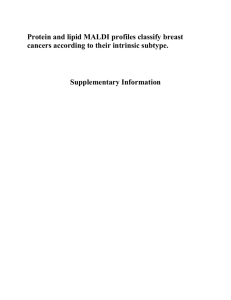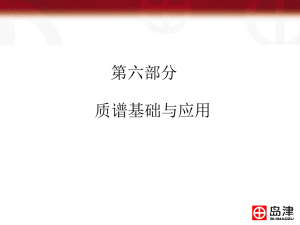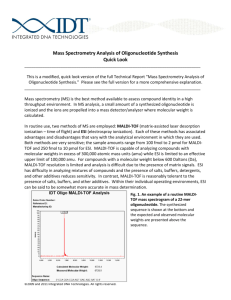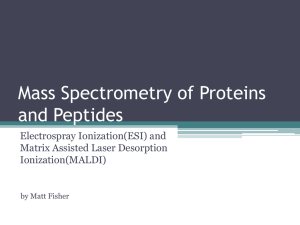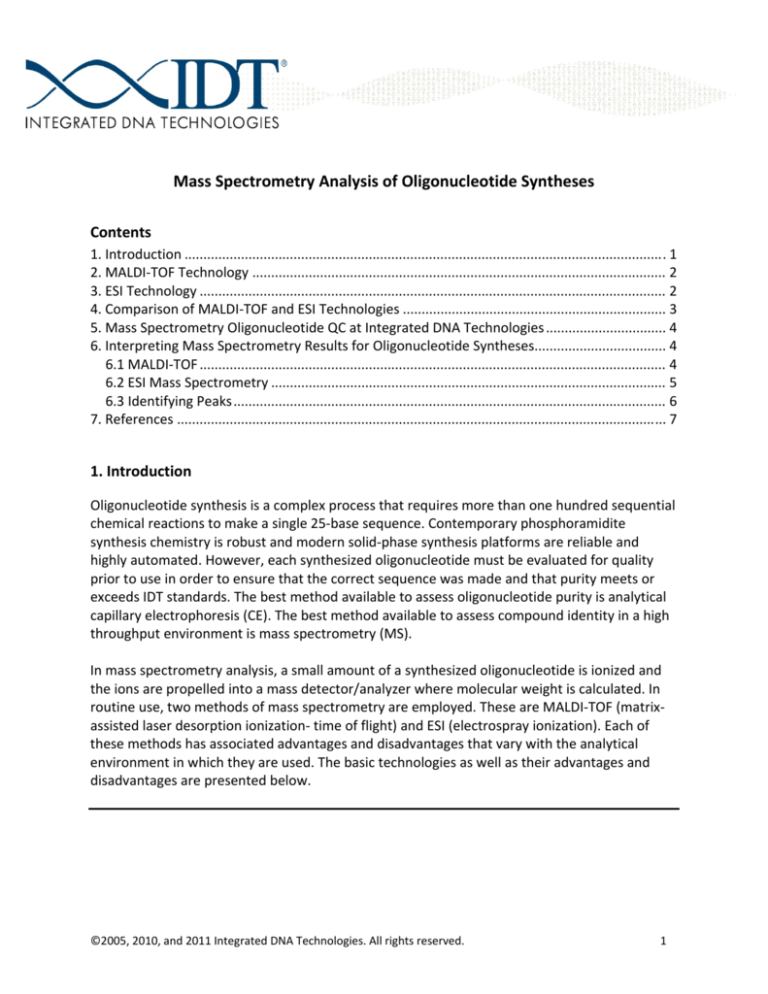
Mass Spectrometry Analysis of Oligonucleotide Syntheses
Contents 1. Introduction ................................................................................................................................ 1
2. MALDI‐TOF Technology .............................................................................................................. 2
3. ESI Technology ............................................................................................................................ 2
4. Comparison of MALDI‐TOF and ESI Technologies ...................................................................... 3
5. Mass Spectrometry Oligonucleotide QC at Integrated DNA Technologies ................................ 4
6. Interpreting Mass Spectrometry Results for Oligonucleotide Syntheses................................... 4
6.1 MALDI‐TOF ............................................................................................................................ 4
6.2 ESI Mass Spectrometry ......................................................................................................... 5
6.3 Identifying Peaks ................................................................................................................... 6
7. References .................................................................................................................................. 7
1. Introduction Oligonucleotide synthesis is a complex process that requires more than one hundred sequential chemical reactions to make a single 25‐base sequence. Contemporary phosphoramidite synthesis chemistry is robust and modern solid‐phase synthesis platforms are reliable and highly automated. However, each synthesized oligonucleotide must be evaluated for quality prior to use in order to ensure that the correct sequence was made and that purity meets or exceeds IDT standards. The best method available to assess oligonucleotide purity is analytical capillary electrophoresis (CE). The best method available to assess compound identity in a high throughput environment is mass spectrometry (MS). In mass spectrometry analysis, a small amount of a synthesized oligonucleotide is ionized and the ions are propelled into a mass detector/analyzer where molecular weight is calculated. In routine use, two methods of mass spectrometry are employed. These are MALDI‐TOF (matrix‐
assisted laser desorption ionization‐ time of flight) and ESI (electrospray ionization). Each of these methods has associated advantages and disadvantages that vary with the analytical environment in which they are used. The basic technologies as well as their advantages and disadvantages are presented below. ©2005, 2010, and 2011 Integrated DNA Technologies. All rights reserved. 1
2. MALDI‐TOF Technology Matrix‐assisted laser desorption ionization mass spectrometry (MALDI) was introduced in the late 1980s [1‐3]. In MALDI‐TOF mass spectrometry a small amount (1‐3 pmol) of a test sample is mixed with a carrier, or matrix, solution, usually 3‐hydroxypicolinic acid, and the mixture is deposited at a fixed position on a sample grid in the MALDI‐TOF instrument. In the desorption phase of the analysis, the oligonucleotide/matrix sample is then vaporized by a pulse of laser light at a fixed wavelength. During desorption some of the oligonucleotide molecules become ionized through protonation (i.e., the oligonucleotide gains a proton and gains a +1 charge relative to the unprotonated molecules). This is the ionization phase. Ionized oligonucleotide molecules are then accelerated by an electrostatic field in the instrument to a common kinetic energy. In the accelerator, ions obey the rule,
E = ½ mv2 (1)
where E is kinetic energy, m is the mass of the ion, and v is the velocity of the moving ion. Under the established condition that E is equal to zA, where z is the charge of the ion and A is the constant accelerating potential applied to all ions, after rearranging (1), we see that, v = (2z/m) (2)
Thus, in the MALDI‐TOF instrument, the velocity of an ion is determined completely by its mass and charge state. Remembering that velocity is simply a function of time and distance, v = d/t (3) the time of flight (TOF) for a fixed distance is completely determined by ion mass and charge state (4). t = (m/2z) (4)
Thus, at the same charge state, lighter ions will arrive at the detector faster than heavier ions. In a MALDI‐TOF instrument the entire mass spectrum is recorded in a fraction of a second as ion flux versus time. This spectrum is then compared to the expected mass of the oligonucleotide based upon the sequence. 3. ESI Technology Electrospray ionization mass spectrometry (ESI) was developed at almost the same time as MALDI [4, 5]. In this process, a sample in a solvent is introduced into the system as a fine spray through a stainless steel capillary and in the presence of a strong electric field. This electrostatic field causes the sample solution to break up into a mist of droplets. The solvent is removed from the droplets by passing nitrogen gas into the interface. The molecules are then conveyed ©2005, 2010, and 2011 Integrated DNA Technologies. All rights reserved. 2
to a high‐vacuum region of the ESI instrument via a low‐pressure transport system. In the low‐
pressure region, which is a heated metal capillary, sample molecules are separated from any remaining solvent. This is termed “declustering.” During this process, the molecules become ionized via deprotonation. In the case of oligonucleotides, multiple protons are removed resulting in a variety of species with multiple negative charges.
A quadrupole mass analyzer acts as a variable mass filter that separates ionized species using only electrical fields generated by a direct current (DC) and superimposed radio‐frequency (RF) potential. These fields are produced by four rods aligned exactly parallel, with opposite rods linked together (i.e., a quadrupole). Ions are introduced in a path parallel to the quadrupole rod direction and, within a given set of field conditions, only ions of a particular mass and charge state can pass through. All non‐conforming ions will have unstable paths and will be filtered out. Thus, if field conditions are varied according to a fixed set of parameters, all ions can be passed and a mass spectrum is acquired. Here again, under the conditions of ESI, variation in the mass spectrum will be completely determined by ionic masses and these variations can be compared to an expected value determined by the known mass of the oligonucleotide sequence. 4. Comparison of MALDI‐TOF and ESI Technologies Hop and Bakhtiar presented a set of advantages and disadvantages of MALDI‐TOF and ESI in a review published in 1997 [6]. In general, both methods are very sensitive for sample amounts in the range of 100 fmol to 2 pmol for MALDI‐TOF and 250 fmol to 10pmol for ESI. MALDI‐TOF is capable of analyzing compounds with a molecular weight in excess of 300,000 atomic mass units (amu) while ESI is limited to an effective upper limit of 100,000 amu. MALDI‐TOF resolution is limited and analysis of compounds with a molecular weight below 600Daltons (Da) is difficult due to the presence of matrix signals. However, ESI has difficulty in analyzing mixtures of compounds and the presence of salts, buffers, detergents, and other additives reduces sensitivity. MALDI‐TOF is reasonably tolerant to the presence of salts, buffers, and other additives. Within their individual operating environments, ESI can be said to be somewhat more accurate in mass determination.
Hail et al. compared ESI and MALDI‐TOF technologies in the specific operational environment of oligonucleotide analyses [7]. MALDI‐TOF is their method of choice because it is relatively easy to operate, offers high sensitivity for oligonucleotides, and is well suited to a high‐throughput environment. They note, however, that “MALDI‐TOF is not particularly effective when analyzing long (50 bases) and/or fragile oligonucleotides.” [7]. They demonstrated that ESI technology maintains mass accuracy, resolution, and sensitivity over an oligonucleotide size range of 20 to more than 120 bases. The data presented by Hail et al. are shown in Table 1. ESI performs slightly better even for shorter oligonucleotides, but the greatest advantage is seen for syntheses longer than 50 bases.
©2005, 2010, and 2011 Integrated DNA Technologies. All rights reserved. 3
Table 1 Experimental mass accuracy for standard oligonucleotides analyzed by MALDI‐TOF and ESI Source: Hail et al. [7]
MALDI‐TOF ESI‐LC‐MS Oligonucleotide Calculated Experimental Error Experimental mass (D) mass (D) (ppm) mass (D) 10mer 2993.0 2992.1 ‐300.7 2993.1 20mer 6168.1 6167.4 ‐113.5 6167.6 40mer 12300.0 12298.6 ‐113.8 12299.7 60mer 18410.0 18414.6 249.9 18410.1 80mer 24661.1 24664.7 146.0 24661.0 100mer 30951.1 30978.3 878.8 30950.6 120mer 37031.0 37121.6 2446.6 37030.0 Error (ppm) 33.4 ‐81.1 ‐24.4 5.3 ‐4.1 ‐16.2 ‐27.0 5. Mass Spectrometry Oligonucleotide QC at Integrated DNA Technologies IDT currently uses two different mass spectrometry systems: a MALDI‐TOF instrument and an ESI instrument. The combination of these systems allows Integrated DNA Technologies to offer mass spectrometry QC on every oligonucleotide made. This QC data is available on‐line for every shipped oligonucleotide.
6. Interpreting Mass Spectrometry Results for Oligonucleotide Syntheses
Because IDT performs mass spectrometry QC on every single oligonucleotide and makes those data available on‐line, it is important that customers are able to interpret the provided mass spectrometry results. Here we present a tutorial on mass spectrometry data interpretation. 6.1 MALDI‐TOF To begin, it is important to note that mass spectrometry does not measure mass directly but, rather, it measures a mass/charge ratio (m/z). Ideally, for MALDI‐TOF, a single ionized species is present (molecules that gain a single proton, measured as M‐H+). Some molecules gain two protons in the desorption phase and represent M‐2H+. Such multiple ionized species are rare and can be distinguished from the single‐ionized species due to their altered mass/charge ratio.
©2005, 2010, and 2011 Integrated DNA Technologies. All rights reserved. 4
A mass spectrum is a useful QC tool that helps verify that a custom oligonucleotide was synthesized correctly, more specifically, that it has the expected molecular weight based upon the requested base sequence. While significantly more accurate than other methods used to estimate oligonucleotide size such as polyacrylamide gel electrophoresis (PAGE), MALDI‐TOF mass spectrometry does have some limitations that must be considered when interpreting results. Even with good machine calibration, accurate measurement by MALDI‐TOF is limited to oligonucleotides less than Figure 1. An example of a routine MALDI‐TOF mass 50 bases in length. Oligonucleotides spectrogram of a 22‐mer oligonucleotide. The synthesized sequence is shown at the bottom and the greater than 50 bases in length “fly” expected and observed molecular weights are presented poorly in a MALDI‐TOF instrument above the sequence.
and an insufficient number of ionized particles reach the detector. This results in spectra with lower resolution. While measurements of longer oligonucleotides are sometimes within a few Daltons of expectation, mass estimates can only be guaranteed to be accurate within 0.2%. For example, a 50‐mer having a calculated molecular weight of 15,130 might have a measured molecular weight of 15,150 and “pass” MALDI‐TOF QC since this measurement lies within the resolution range of the instrument. However, as shown in Figure 1, measurements for shorter oligonucleotides are typically much more precise, with errors of 0.1% being commonly achieved for 22‐mers.
6.2 ESI Mass Spectrometry
Figure 2. A raw data trace of a purified 60‐mer In ESI mass spectrometry the parent ions oligonucleotide produce by ESI mass spectrometry. are not observed. Rather, what is present ©2005, 2010, and 2011 Integrated DNA Technologies. All rights reserved. 5
are multiple negatively charged species. The raw data trace of a purified 60‐mer oligonucleotide is shown in Figure 2 where the mass measurement range is 550 m/z to 1500 m/z. All of the peaks labeled with “A” are from the same oligonucleotide. The differences among these peaks are simply m/z ratios generated by different amounts of deprotonation. The m/z ratio is calculated by taking the molecular weight of an oligonucleotide, subtracting out a number of H+ and then dividing by the number of H+ removed. For example, the peak labeled 22A at 820.8 m/z can be calculated as (18,079.8 – (22 * 1.0079))/22, the peak labeled 21 A at Figure 3. A routine ESI mass spectrogram of a 60‐
859.9 m/z is similarly calculated as mer oligonucleotide. The synthesized sequence is (18,079.8 – (21 * 1.0079))/21, and so on. shown at the bottom and the expected and These raw data are then processed using observed molecular weights are presented above a deconvolution algorithm that takes all the sequence.
of the peaks present in the trace and performs the reverse computation. The results of this deconvolution analysis are then presented in the form of an ESI trace as shown in Figure 3. The expected error in ESI analyses of oligonucleotides above 14,000 Da is 0.02%. When running through the raw data, the deconvolution program looks for groups of peaks that all add up to the same parent peak. Consequently, the deconvolution analysis removes almost all of the noise because noise does not add up to a consistent figure. Thus, a final deconvoluted ESI trace has a smooth baseline compared to a final MALDI‐TOF trace.
6.3 Identifying Peaks
In both MALDI‐TOF and ESI mass spectrometry results there will be a main peak representing the synthesized oligonucleotide. However, there can be, and often are, additional peaks present in the final traces. During MALDI‐TOF analysis, depurination of the oligonucleotide can occur as a result of heating (laser ionization) in the acidic environment (the matrix). Depurination can occur during ESI analysis because of heating in the transport region of the ESI instrument. Depurination can create secondary peaks having 135 (dA) or 151 (dG) mass units less than the major peak. In addition, synthetic oligonucleotides made using phosphoramidite chemistries employ protecting groups on the amines in dA, dC, and dG phosphoramidites in order to prevent branching and other undesired side reactions from occurring during chain elongation. Protecting groups are cleaved off post‐synthetically during the final “deprotection” and “desalting” steps. Incomplete removal of these side groups can be observed in mass spectrometry. The benzoyl protecting group on dA and dC will add 104 daltons while the isobutyryl group on dG adds 70 daltons. Similarly, the dmf group used with rapid deprotecting‐
©2005, 2010, and 2011 Integrated DNA Technologies. All rights reserved. 6
dG will add 55 daltons and the 5’‐terminal dimethoxytrityl group adds 302 daltons. All of these additional masses are easily detected by mass spectrometry. Finally, modifications of oligonucleotides add mass to the synthesis. Modifications commonly used in oligonucleotides are well characterized and their masses are taken into account in the final mass spectrograms produced. A list of mass contributions for the most often requested modifications of DNA and RNA oligonucleotides are listed in the IDT modifications page. Further, the anhydrous molecular weight of both unmodified and modified oligonucleotides can be calculated using OligoAnalyzer 3.0 which is located in SciTools on the IDT website. 7. References
1. 2. 3. 4. 5. 6. 7. Karas M and Hillenkamp F. (1988) Laser desorption ionization of proteins with molecular masses exceeding 10,000 daltons. Anal Chem, 60(20): 22992301.
Karas M, Bahr U, and Giesmann U. (1991) Matrix‐assisted laser desorption ionization mass spectrometry. Mass Spectrom Rev, 10: 335357.
Stults JT. (1995) Matrix‐assisted laser desorption/ionization mass spectrometry (MALDI‐
MS). Curr Opin Struct Biol, 5(5): 691698.
Fenn JB, Mann M, et al. (1989) Electrospray ionization for mass spectrometry of large biomolecules. Science, 246(4926): 6471.
Smith RD, Loo JA, et al. (1991) Principles and practice of electrospray ionization‐mass spectrometry for large polypeptides and proteins. Mass Spectrom Rev, 10: 35451.
Hop CECA and Bakhtiar R. (1997) An introduction to electrospray ionization and matrix‐
assisted laser desorption/ionization mass spectrometry: essential tools in a modern biotechnology environment. Biospectroscopy, 3: 259280.
Hail ME, Elliott B, and Anderson A. (2004) High‐throughput analysis of oligonucleotides using automated electrospray ionization mass spectrometry. Am Biotech Lab, 22: 1214.
©2005, 2010, and 2011 Integrated DNA Technologies. All rights reserved. 7

